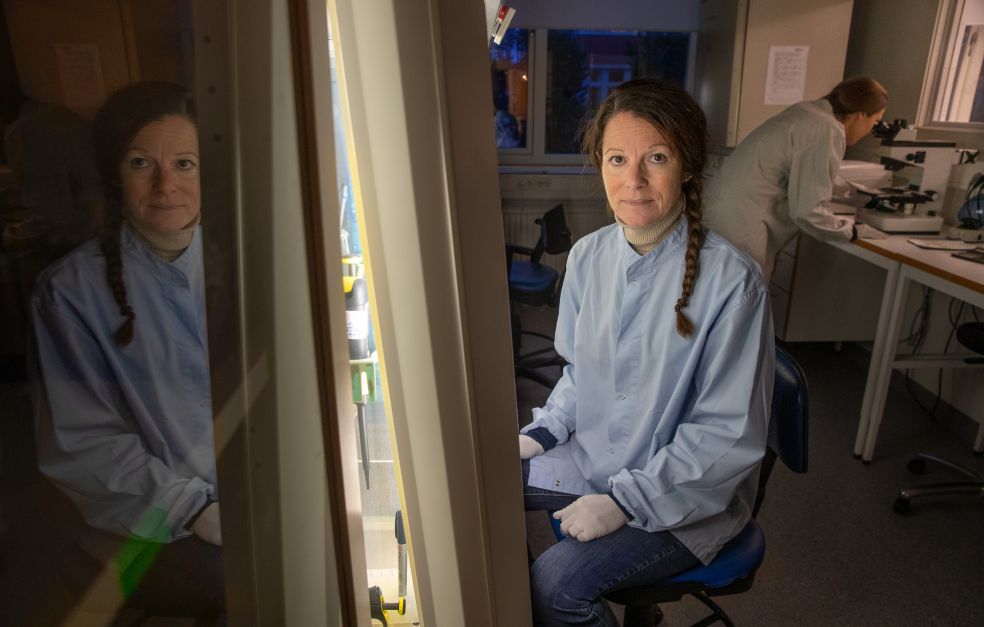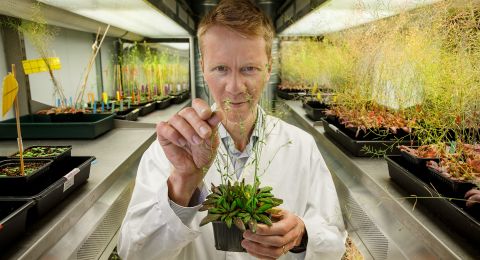Pernilla Wittung-Stafshede’s work on copper-binding proteins has taken her from pure basic research to a growing number of projects closely related to human diseases. As a Wallenberg Scholar, she is studying the part played by proteins in cancer and diseases of the brain.
Pernilla Wittung-Stafshede
Professor of Biological Chemistry
Wallenberg Scholar
Institution:
Chalmers University of Technology
Research field:
Protein folding mechanisms and copper-binding proteins
Proteins will only work if they fold into the right shape. The folding of metal-binding proteins, particularly those that bind copper, has been Wittung-Stafshede’s research field for many years. She was the first person in the world to examine the mechanisms of human copper-transporting proteins. At first, she wanted to see how proteins folded and metals were bound in healthy cells, but over time her focus has shifted almost entirely to protein changes in the context of diseases.
“I’m still studying copper-binding proteins and their functions. But now my work is largely confined to biological processes that play a part in diseases such as breast cancer and Parkinson’s,” she says.
Over the past few years, several of her projects have focused on alpha-synuclein, a protein that plays a key role in Parkinson’s disease. It occurs normally in the brain, but in Parkinson’s sufferers it changes shape and clumps into amyloids. Amyloids are insoluble, fibrous aggregates of misfolded proteins. Wittung-Stafshede is studying how other proteins interact with the alpha-synuclein, causing it to form either more or fewer amyloids. Her research team recently attracted considerable attention when their findings showed that a protein present in fish can bind alpha-synuclein in a way that prevents it from forming harmful amyloids. This may mean that people with a diet rich in fish run less risk of developing Parkinson’s.
Bacteria and diabetes impacting the brain
With collaborators at Caltech in California, Wittung-Stafshede was also involved in studying two types of mice, both of which had been genetically manipulated to develop Parkinson’s. One type had been bred to lack any bacteria at all in its stomach and intestines; the other had a normal gut flora. The disease progressed more rapidly in the mice with bacteria.
“Intestinal bacteria contain harmless amyloids made up of the bacterium’s own proteins, and it is conceivable that they trigger the disease by impacting alpha-synuclein aggregation. The bacteria might be able to reach some cells in the intestinal mucosa that are rich in alpha-synuclein. Those cells are in direct contact with the brain via neural pathways,” Wittung-Stafshede explains.
She has also collaborated with fellow researchers at Umeå University, where she used to work, in an attempt to understand why patients with type 2 diabetes run a greater risk of developing Parkinson’s disease. It appears that a hormone involved in diabetes accelerates alpha-synuclein aggregation.
“Alpha-synuclein is found throughout the body, including the pancreas, where diabetes develops. Perhaps the protein forms clumps fairly randomly, but only brain cells are so sensitive that they die. We don’t know. We know very little about the biology of these processes. I think we have to start on a small scale and study in test tubes how proteins behave when we add one more thing, and then another, and another…”
“The grant I have received as a Wallenberg Scholar feels like a gift – to be used for what I consider appropriate at a given point. It’s a great feeling. Many of my colleagues are constrained by their projects. I can do whatever appears to be of most interest.”
Copper levels impacting disease
So alpha-synuclein is a copper-binding protein – precisely the kind of protein that Wittung-Stafshede specializes in. Her research team has attempted to trace the source of the protein’s copper ion, and has succeeded in identifying the copper transport protein in the cell that supplies it. When transfer occurs, a complex is formed in which the two proteins bind together, with the copper ion in the middle. The binding prevents the alpha-synuclein from forming clumps. It is known that copper levels fall in the brain cells of patients with Parkinson’s, and Wittung-Stafshede wonders whether this is a cause of the disease: that the alpha-synuclein is “set free” to form amyloid.
Copper also plays a key role in cancer. Cancer cells need more copper than normal cells. The research team at Chalmers University of Technology has established which copper-binding proteins increase or decrease in cancer. Different forms of cancer have different profiles, and the researchers have chosen to concentrate first on breast cancer, since it is so common. It seems that breast cancer cells need a specific copper transport protein to become mobile, which is the first stage in the spread of cancer. Wittung-Stafshede is now collaborating with an oncologist in the U.S., who is testing reducing copper levels in their patients, and sends tissue samples from them to Gothenburg, together with information on how successful the treatment has been.
“It’s incredibly difficult to ascertain protein quantities and make comparisons between material from different patients. The material includes a mixture of many other cells and other biological material, so it’s much more complicated than test-tube experiments, where you know exactly what you’re dealing with. But it’s enormously interesting. The older I get, the more enjoyable and important I think it is to work more closely with the diseases themselves, closer to what is important. This is what I’ve done more and more here at Chalmers.
Text Lisa Kirsebom
Translation Maxwell Arding
Photo Magnus Bergström






